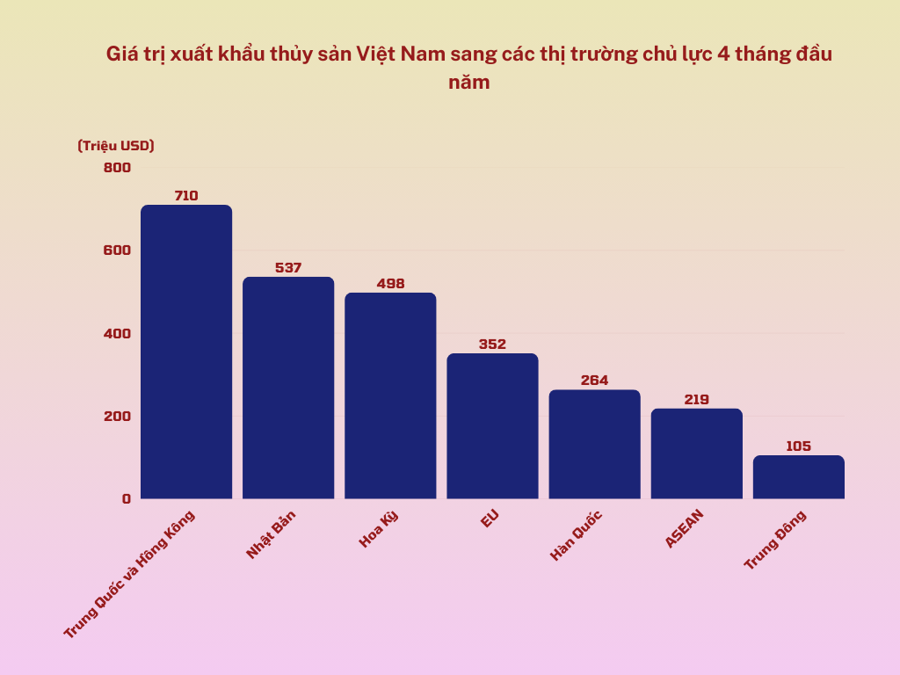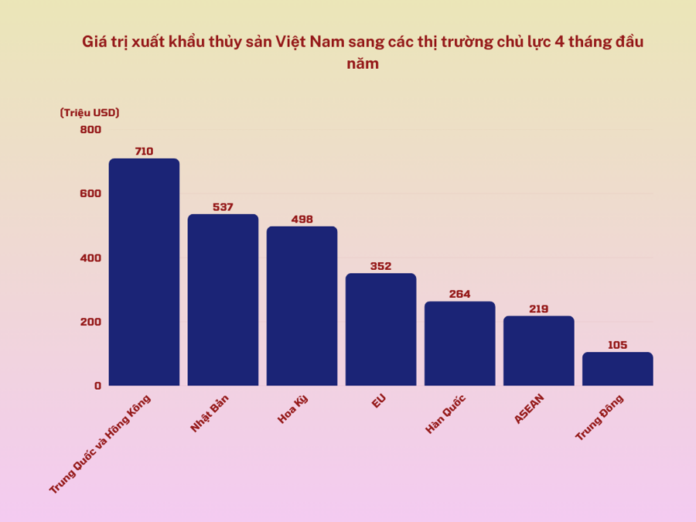According to the Vietnam Association of Seafood Exporters and Producers (VASEP), seafood exports in the first four months of 2025 reached a remarkable $3.3 billion, signifying a 21% increase compared to the same period last year. April alone witnessed a 15% rise, amounting to $894.2 million. However, this growth hasn’t been uniform across product categories and markets, with ongoing tariff uncertainties from the United States presenting notable challenges.
KEY MARKETS SHOWING PROMISE
Delving into specific products, VASEP highlights shrimp as the leading export, generating $1.27 billion in the first four months, marking a substantial 30% increase year-on-year. April’s shrimp exports reached $358.9 million, a 25% surge. This recovery is largely attributed to heightened demand in major markets such as China, the EU, and Japan, coupled with rebounding shrimp prices as global supply and demand dynamics rebalance.
Tra fish ranks second, with exports totaling $632.7 million, up by 9%; April’s performance showed a slight increase of 3%, reaching $174.2 million. Tuna exports amounted to $304.2 million, a modest 1% increase over four months, while April’s figures remained steady at $86.3 million compared to the previous year.
Squid and octopus exports demonstrated robust growth, reaching $216.4 million, an 18% jump over the four months, with April witnessing a notable 22% increase to $54.1 million. Shellfish continued its strong performance, climbing to $83.1 million, an impressive 82% increase, while April’s numbers showed a 36% rise, totaling $21.1 million.
Conversely, other mollusks experienced a 33% decline in April, falling below $0.5 million. However, the cumulative four-month figure still reflected a slight 5% increase. Crab and other crustaceans witnessed a significant 50% surge, totaling $112.1 million; April’s exports reached $27.6 million, an impressive 21% increase.

In terms of market performance, China and Hong Kong retained their position as the largest consumption area, with exports totaling $709.8 million in the four months, a significant 56% increase. April’s figures showed a solid 23% rise, reaching $173.3 million. Japan maintained its second position, with exports amounting to $536.6 million, a notable 22% increase; April’s performance reflected a 13% increase, totaling $134.9 million.
The US market recorded $498.4 million in exports during the first four months, a 7% increase year-on-year, with April’s figures showing an 8% rise to $153.6 million. Despite rebounding after a quiet first quarter, exports to the US continue to face notable impacts from retaliatory tariffs and new technical barriers.
Meanwhile, the EU registered a 17% increase, totaling $351.5 million over four months, although April witnessed a 15% dip to $76.8 million. South Korea followed closely with $264.1 million, a 15% increase; April showed a slight 2% uptick, reaching $64.2 million. Notably, ASEAN emerged as a bright spot, achieving a 25% growth rate and $218.8 million in exports over four months; April witnessed a remarkable 68% surge to $68.2 million.
In contrast, the Middle East was the only market to experience a decline, with April’s exports dipping to $22.8 million, a 26% drop, and the four-month cumulative total falling by 8% to $105.4 million, attributed to weak consumer demand. Other markets contributed $615.1 million, a 13% increase compared to the previous year, while April’s figures showed a substantial 35% increase to $200.4 million.
BOUNTIFUL OPPORTUNITIES FOR TUNA EXPORTS TO RUSSIA
Beyond traditional markets like China, Japan, the US, and the EU, Vietnam’s seafood exports have also witnessed positive signals from niche and emerging markets. Notably, Russia is emerging as a promising partner, especially for tuna, thanks to bilateral cooperation efforts and the strategic utilization of preferential tariffs under the Free Trade Agreement between Vietnam and the Eurasian Economic Union.
VASEP, citing statistics from Vietnam Customs, reveals that exports to Russia reached nearly $45 million in 2024, a fivefold increase compared to 2020, marking the highest level in the last decade. In the first three months of 2025 alone, tuna exports to Russia exceeded $10 million, a 15% increase compared to the same period in 2024.

According to VASEP, based on insights from trade counselors, the current context presents numerous advantages and opportunities for economic and trade cooperation between Vietnam and Russia. Specifically, the two economies are complementary, with Vietnam importing Russian products for production and consumption, while Russia imports tropical agricultural products, seafood, and other foodstuffs from Vietnam.
Additionally, Russia is among the top 30 tuna-importing markets globally, and its tuna imports have been steadily increasing year after year, doubling in value within five years to reach nearly $90 million in 2023.
However, VASEP experts acknowledge that recent challenges, including transportation, payment, and business travel, have posed significant obstacles to bilateral trade. These hurdles are actively being addressed to facilitate smoother commerce between the two nations.
Exports from Vietnam to Russia can utilize the direct sea route from Vladivostok to Haiphong and Ho Chi Minh City, with an approximate travel time of 8–11 days. Alternatively, there’s the international railway route from Vietnam via China and Kazakhstan to Moscow, taking around 35–40 days.
Regarding payments, businesses from both countries can conveniently use the Russian ruble and the Vietnamese dong for bilateral trade transactions. Moreover, Russia’s introduction of electronic visas with a 15-day stay period for Vietnamese citizens has facilitated business travel for traders.
It’s worth noting that Vietnam and the Eurasian Economic Union, of which Russia is a member, signed a Free Trade Agreement in 2015 (VN-EAEU FTA). This agreement came into force in October 2016, and today, most goods traded between the two countries benefit from a 0% import tax rate or very low tariffs. Businesses on both sides should leverage the advantages offered by this agreement to boost bilateral trade and investment.
However, to ensure stable exports to the Russian market and avoid quality-related disputes, VASEP emphasizes the importance of Vietnamese enterprises thoroughly understanding and adhering to the host country’s regulations regarding quality, packaging, and labeling for their products.
The Billion-Dollar Species: Vietnam’s Treasure Trove of Exotic Exports.
The product is one of Vietnam’s key exports and a cornerstone of its thriving economy. With a rich history and a unique, distinctive flavor, this good has become a global favorite. Grown and crafted with care, it embodies the essence of Vietnam’s diverse and vibrant culture, offering a taste of its vibrant landscapes and rich heritage.
“Elevating Vietnam-Laos Cooperation: Aiming for a Transformative, Focused, and Impactful Partnership”
Within the framework of his visit to Laos and co-chairing the 47th meeting of the Vietnam-Laos Inter-governmental Committee, on the morning of January 10, in Vientiane, Prime Minister Pham Minh Chinh met with Thongloun Sisoulith, General Secretary of the Lao People’s Revolutionary Party Central Committee and President of Laos.
Seafood Exports Surpass $10 Billion: Unveiling the 2 Star Products
The seafood industry has witnessed impressive growth in exports, inching closer to the significant milestone of $10 billion annually. This remarkable journey can be largely attributed to the stellar performance of two key players: shrimp and catfish. As the industry surges ahead, these two aquatic powerhouses have emerged as the primary contributors to its success, solidifying their status as the backbone of this thriving sector.
Seafood Exports on Track to Hit $10 Billion Landmark
With the current growth trajectory, Vietnam’s seafood industry is on track to achieve its target of $10 billion for the full year 2024, marking an impressive 11.5% increase from 2023. Shrimp and catfish will remain the key drivers, with projections of reaching $4 billion and $2 billion, respectively.
Seafood Exports for the First Ten Months Reached $8.3 Billion, with Key Products Showing Strong Growth
The seafood industry is swimming towards success, with October’s achievements pushing the 10-month tally to a remarkable $8.33 billion in export turnover. This impressive figure marks a 12% increase compared to the same period last year, showcasing the sector’s resilience and growth. Key products such as shrimp, pangasius, and tuna have all witnessed positive growth trajectories, contributing to the industry’s overall triumph.





















